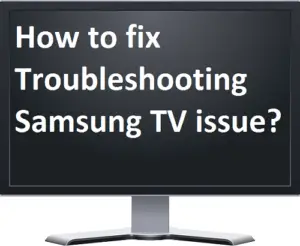How to fix Troubleshooting Samsung TV Issues
Introduction:
Samsung TVs have earned a reputation for their stunning display quality, innovative features, and user-friendly interfaces. However, like any electronic device, Samsung TVs can encounter issues from time to time that may disrupt your viewing experience. In this blog, we will provide you with a comprehensive guide on troubleshooting common Samsung TV issues, empowering you to resolve them effectively and restore your TV to optimal performance.
I. Basic Troubleshooting Steps:
Check Power and Connections:
Ensure that your Samsung TV is properly plugged into a working power outlet.
Verify that the power cable is securely connected to the TV and the outlet.
Confirm that other devices connected to the TV (e.g., cable box, game console) are also properly powered and connected.
Restart the TV:
Sometimes, a simple restart can resolve minor issues. Turn off your Samsung TV, unplug it from the power source, wait for a few minutes, and then plug it back in. Turn on the TV and check if the issue persists.
Update Software:
Keeping your Samsung TV’s software up to date is crucial. Navigate to the TV’s settings menu, find the Software Update section, and follow the prompts to check for and install any available updates.
II. Common Samsung TV Issues and Solutions:
A. No Picture or Blank Screen:
Check Input Source: Ensure that the correct input source is selected on your TV. Press the Source or Input button on your remote control to cycle through the available input options.
Verify Cables: Confirm that all cables (HDMI, AV, etc.) are securely connected to the appropriate ports on both the TV and the external devices. Try using different cables if necessary.
Adjust Display Settings: Access the TV’s picture settings menu and adjust the brightness, contrast, and other display settings to see if the picture returns.
B. No Sound or Audio Issues:
Check Mute and Volume: Make sure the TV’s volume is not muted or set to a very low level. Use the volume buttons on your remote control to increase the volume.
External Audio Devices: If you’re using external audio devices such as soundbars or speakers, ensure they are powered on, properly connected, and set to the correct input/source.
Audio Output Settings: Verify that the TV’s audio output settings are correctly configured. Access the TV’s audio settings menu and select the appropriate audio output option (e.g., TV speakers, external speakers).
C. Network Connection Problems:
Check WI-Fi Signal: Ensure that your Samsung TV is within range of your Wi-Fi network and the signal strength is strong. You can try moving the TV closer to the router or use a Wi-Fi range extender if needed.
Restart Router: Power cycle your Wi-Fi router by turning it off, waiting for a few seconds, and then turning it back on. This can resolve temporary connectivity issues.
Network Reset: On the TV, go to the network settings menu and perform a network reset. This will clear any network settings and allow you to set up the connection again from scratch.
III. Advanced Troubleshooting Steps:
Factory Reset:
If you have exhausted all other troubleshooting steps and the issues persist, you may consider performing a factory reset. This will restore the TV to its original settings, eliminating any software-related problems. However, note that a factory reset will erase all personalized settings and data, so make sure to back up important information before proceeding.
Contact Samsung Support:
If you are unable to resolve the issue on your own, reach out to Samsung’s customer support. They can provide specific guidance tailored to your TV model and assist you further in troubleshooting and resolving the problem.
IV. Preventive Measures:
Keep Software Updated: Regularly check for and install software updates provided by Samsung. These updates often contain bug fixes, performance enhancements, and improved compatibility with external devices.
Protect from Power Surges: Use a surge protector or uninterruptible power supply (UPS) to safeguard your Samsung TV from power fluctuations and surges.
Proper Ventilation: Ensure that your TV has adequate ventilation to prevent overheating. Avoid placing the TV in enclosed spaces or blocking the ventilation ports.
Conclusion:
By following the troubleshooting steps and solutions outlined in this comprehensive guide, you can effectively troubleshoot and resolve common issues encountered with Samsung TVs. Remember to start with basic troubleshooting steps, such as checking power connections and performing software updates. If the problem persists, move on to more specific solutions based on the particular issue you are facing. With a little patience and persistence, you can restore your Samsung TV to its optimal performance and continue enjoying a remarkable viewing experience.
